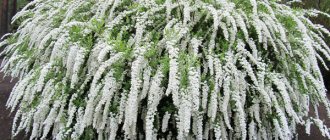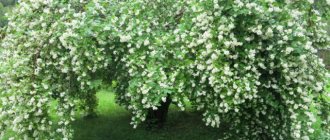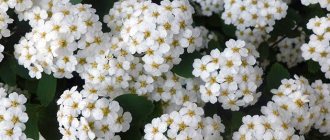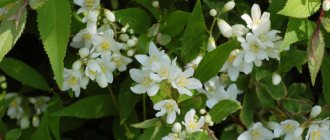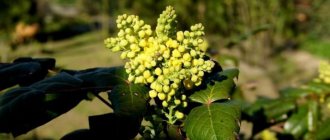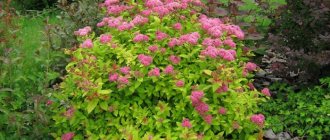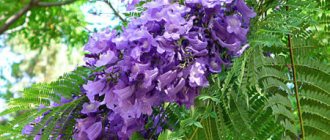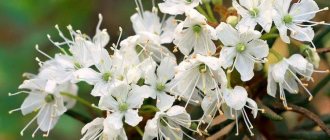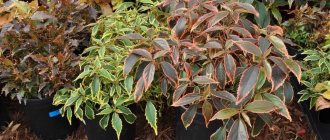Spirea (translated from Greek the word means spiral, bend) has long been known and loved in Rus'. It is often popularly called meadowsweet, and this word applies to the genus Spiraea, although the meadowsweet plant is a herbaceous rather than shrubby species.
Spiraea gray Grefsheim is the most common type of ornamental shrubs in garden plots. Its hanging branches with dense white flowers resemble a floral waterfall.
Description of Spirea Grefsheim
Spiraea gray Grefsheim, the description of which is of interest to many gardeners, has a spherical shape and an almost identical height and width of 1.5-2 m. The culture of this variety can be easily trimmed, which allows you to adjust the size. The spreading crown is formed by flexible branches of a red-brown hue.
Spiraea has excellent decorative properties
The young plant has straight vertical shoots. It has narrow, lanceolate, pointed leaves. The bottom is covered with gray fluff. The leaves reach 2-3 cm in length and 1 cm in width.
The root system is distinguished by many branches and its ability to take root in different types of soil. According to the description of Grefsheim's spirea, its flowers have white petals and form corymbose inflorescences. They decorate flowers from mid-May to the end of June. In good weather, flowering lasts 1.5 months.
Important! Beekeepers often plant crops near their homes. The bush is a wonderful spring honey plant.
Diseases and pests
When growing a Grefsheim hybrid on a personal plot, there is a possibility of encountering uninvited guests, in particular, garden snails, aphids, and spider mites. They cause a lot of problems, so the gardener needs to regularly inspect the gray spirea Grefsheim. The earlier pests can be detected, the easier it will be to fight them.
For preventive purposes, they are treated with the biological preparation Fitoverm, which will destroy slugs when they appear and protect the plant from possible ailments.
Young shoots of the Grefsheim hybrid are attractive to aphids. Colonies of this insect inhabit the underside of the leaf and feed on the sap of branches and leaves. They can be eliminated using chemical treatment. Among the insecticides, Pirimor and Actellik have proven themselves well. Minor accumulations of aphids can be affected by infusion of wormwood, celandine, and hot pepper.
Spider mites cause serious damage to the Grefsheim hybrid. The plant takes on an unhealthy appearance, numerous holes are observed on the leaf plate, untimely yellowing and flying of leaves. Karbofos and Akrex products will help in the fight against spider mites.
In rare cases, Grefsheim spirea suffers from infections: ascochyta blight, septoria blight or ramularia blight. A large number of gray spots appear on the foliage. In this case, treatment will only help at the initial stage of the disease. When symptoms have just begun to appear, the Grefsheim hybrid should be treated with colloidal sulfur, Bordeaux mixture or Fundazol.
Planting a plant
Spirea Arguta - description, planting and care
Spiraea Greif Shine is easy to care for. Planting a plant is not difficult. In this case, rooted cuttings are most often used for this purpose.
Planting from seeds
The culture does not propagate by seed. The germination parameters of planting material are 4-5%. If desired, this fact can be established experimentally.
Planting seedlings in open ground
It is recommended to plant the plant in open soil in the warm season. It is best to do this in the spring. The flower will take root well. When creating a hedge, the distance between bushes is at least 0.5 m. For group plantings, the distance should be 1 m.
The planting hole should be 2-3 times larger than the root ball. A drainage layer is poured onto the bottom of the recess. It may include stones, crushed bricks or expanded clay.
The crop is usually grown from seedlings
III. Planting and propagation
Spiraea Grefsheim is planted in the fall, when the leaves have completely fallen, or in the spring - until the buds open. When decorating a hedge, you should maintain a half-meter distance between the bushes. The row spacing should be at least 40 cm. When planting meadowsweet in groups, leave a meter distance between the bushes. The diameter of the planting hole should be one third greater than the volume of the root system. The optimal depth of the hole (taking into account the drainage layer) is 40-50 cm.
Gray spirea is propagated in three ways:
- seeds;
- cuttings;
- layering.
The characteristics of the offspring of sexual reproduction of hybrids are unpredictable, so Grefsheim spirea is usually propagated vegetatively. When cuttings, young shoots are separated from meadowsweet, divided into fragments about 10 cm in length and planted in the soil or in prepared containers. By autumn, the cuttings take root well. Spiraea Grefsheim is propagated by layering in the spring. The outer branches are bent to the ground, fixed and watered abundantly all summer. In the fall or next spring, the plants are divided.
We will illustrate the process of propagating spirea by cuttings:
It is correct to plant cuttings at an angle of 45 degrees. The sand in the pot should always be wet
Secrets of proper care
Spiraea Grefsheim is a plant from the “self-growing” category; it does not show any particular vagaries in care. It is not difficult to care for, the requirements are standard - moderate watering, fertilizing, pruning, weeding, loosening.
Trimming
The lifespan of Grefsheim spirea is up to 30 years. To rejuvenate, the plant should be pruned periodically. To do this, leave a few strong branches, the rest are removed during the first growing season. For preventive purposes, it is recommended to thin out Grefsheim spirea once every two years, cutting off weakened and damaged shoots. To form the crown, pruning is done in the first spring months.
Soil care
The roots of Grefsheim spirea do not grow very deep and require mulching of the soil. To do this, just cover it with a layer of peat after watering. Water the plant twice a month (one and a half buckets of water). The soil must be loosened to remove weeds. As a top dressing, use mullein infusion with superphosphate (10 g per bucket of infusion) or complex fertilizer. Meadowsweet needs feeding most of all before flowering and after pruning.
How to care for spirea Grefsheim
Spiraea Wangutta - botanical description and varieties
To achieve success in growing spirea Grefsheim and avoid stunting, it is worth providing her with comprehensive care.
Watering
The description of Grefsheim spirea says that the plant does not need frequent watering. It is recommended to moisten the soil twice a month. It is recommended to pour 1.5 buckets of water under the bush. In dry weather, the soil should be moistened more often.
The soil in which the bush grows must have high water permeability. The soil around the crop must be systematically loosened and weeded.
The plant needs to be watered in a timely manner
Top dressing
Planting and caring for the ashen spirea Grefsheim includes the mandatory application of fertilizers. Chicken manure and cow infusion are used for this purpose. It is recommended to fertilize before flowering and after spring pruning is completed.
Trimming
It is recommended to pay special attention to crop pruning. The procedure should be performed in July after flowering has ended. Young shoots that have bloomed need to be shortened to strong buds. They form throughout the stem, which is why the procedure should not be carried out annually.
Important! If you cut off living buds, the spirea will not be able to bloom. During the first procedure in the spring, it is worth removing weak shoots up to the area where large buds are located.
Action, brief description
Deutzia in the description is a deciduous shrub reaching only one and a half to two meters in height. A characteristic feature of the deutzia shrub is the peeling of the bark, which is also characteristic of other representatives of the Hydrangeaceae genus. On old shoots you can see the bark hanging from them like rags. This is not a sign of disease, but a normal property of adult shoots.
The homeland of this amazingly beautiful shrub is Japan and China. The plant is very widespread in the wild in North America and some regions of Europe. In the southern part of Russia you can also find this bush in nature.
Although caring for this ornamental plant is somewhat troublesome, the beauty of the flowering shrub makes you forget about the time and effort spent. Deutzia is a unique plant that looks simply magical when in bloom. Be sure to plant a delightful deutia on your site, which will decorate your summer garden.
Reproduction methods
Spiraea Willow - care and cultivation
Spiraea ashy Grefsheim propagates by cuttings. Woody shoots are suitable for this. They are trimmed, the top part and some leaves are removed. After this, the cutting must be placed in moist, loose soil. To ensure that the seedlings are strong, an interval of 20 cm is left between them. It is best to grow cuttings in a warm place with high humidity.
Also, propagation of the crop can be carried out by dividing the rhizomes. The procedure is carried out in the fall. To do this, the bush is dug up and divided. When planting in the ground, drainage is organized.
Features of planting in the Urals
Growing spirea in the Urals is not particularly difficult. The main thing is to comply with several conditions:
- choose the right planting time depending on the flowering time of the variety;
- qualitatively prepare the territory, taking into account the positive and negative proximity to other plants;
- carry out landing according to technology.
When to plant
Planting of the plant in question can be carried out in spring or autumn . All varieties that bloom in summer are planted in the spring, before foliage appears on the plants. The remaining varieties are placed in an open area - in the fall, after leaf fall. Considering that Nippon spirea begins to bloom in June, it should be planted in the spring.
Video: Spiraea Nippon
Preparing a place for a bush
When starting to grow the crop in question, you should take into account that it is a perennial shrub. Such plants live from 30 to 50 years. Accordingly, during this time a certain area will be occupied by bushes. Plants need a fairly large amount of light (light partial shade is acceptable), so it is better to choose an area on the south or southeast side. From the north, bushes should be protected from drafts.
- Favorable neighbors for the crop in question:
- thuja;
- juniper;
- dwarf spruce.
Important! In the shade, spirea will form a very small number of flowers and develop poorly.
Considering that over time, spirea begins to produce a large amount of basal shoots, it should not be planted next to large trees . This plant is also distinguished by the high growth strength of its rhizome, which, as it grows, can destroy the foundation of buildings or a fence. Taking this into account, a distance of 5 m should be maintained from the plant to the nearest structure of a similar design.
The area for planting begins to be prepared in the fall . At this stage, all plant debris, stones and other debris are removed. Then deep cultivation is carried out (30–40 cm). After this, disinfect the area with a 3% solution of copper sulfate. Add 300 g of substance to 10 liters of water. For each m², 1 liter of working fluid is consumed. A week later, the area is again cultivated to a depth half as deep as the first time. For digging, manure, turf-leaf soil, and peat (10 kg/m²) are first added.
Landing rules
A week before planting, the site is dug up to a depth of 20 cm. For each m², 5 kg of sand and peat are added. 2 days before planting, they begin to prepare the holes. If there are several plants, then a distance of 3.5 m is maintained between the pits. A similar step is taken between the rows. The depth of the hole should be oriented towards the size of the root system of the seedlings, i.e. 2.5–3 times larger.
A layer of pebbles (you can take expanded clay, broken brick or other drainage material) 15 cm high is laid out at the bottom of the pit. After this, 5 cm of soil from the pit is laid out, mixed with compost in a 1:1 ratio.
Step by step planting process:
- Inspect the roots, cut off the dried ones. Then immerse the rhizome in the Kornevin solution (1 teaspoon of powder per 1 liter of water) for 10 hours.
- Place the seedling vertically in the hole.
- Distribute the rhizome evenly over the entire area of the pit.
- Fill the hole with soil, compacting it periodically.
- Water the plant with 20 liters of water.
- After absorbing the liquid, cover the tree trunk circle with straw or sawdust (layer 10 cm high).
Use in landscape design
The plant can decorate any flower garden. To get a harmonious composition, you should choose additions in the form of crocuses, tulips, and daffodils. Bushes are also placed along a mesh or fence. After a few years they form a beautiful hedge.
The flower is actively used in landscape design
Spiraea bushes differ in flowering times. Many designers advise placing different varieties of this crop nearby. This helps in creating interesting compositions. Flowering bushes are combined with plants with small decorative berries.
Spiraea Grefsheim has excellent decorative properties. In order for the culture to develop well and bloom profusely, it is necessary to strictly follow the rules of care. It should be comprehensive and include timely watering, fertilizing, and pruning. Protection of crops from diseases and parasites is of no small importance.
Spiraea gray in the landscape
Landscaped gardens are becoming increasingly popular, and shrubs such as spirea are in constant demand. They are used to create hedges, and for alpine slides, and for group compositions.
To form beautiful groups, the best partners for gray spirea are broom, viburnum, multifloral oleagin and conifers. Against their background and in their surroundings, spirea looks even more elegant and whiter.
Types and varieties of delphinium
Perennial lupine - when to plant seedlings
Representatives of the spur genus can be divided into 3 groups:
- The tallest - the tall delphinium grows up to 3 meters. The leaf blades have a rich green color, the stem is covered with villi. Inflorescences are racemose, dense;
- Large-flowered - represented by an annual plant up to 0.8 m in height. The stem has vertical branching. Delphinium begins to bloom in mid-summer;
- Field - also classified as annuals, height - up to 2 meters. Flowering period – July-September. The inflorescences are pyramidal, there are both double and simple flowers.
It is worth talking in more detail about some interesting varieties of larkspur.
Delphinium white
Fans of perennial plants should take a closer look at the Galahard variety. Distinctive features include tall growth (about 2 meters) and the presence of snow-white double flowers with a diameter of up to 7 cm. The inflorescence is cone-shaped.
White variety
The plant is used in the design of borders and walls. White delphinium stands very well when cut.
Delphinium yellow
This shade is characteristic of the semi-bearded delphinium, which grows in Iran and Afghanistan; it is not a hybrid. The height of the plant reaches 120 cm. Those who want to grow a beautiful flower are recommended to purchase “Solar Knight” seed material. Here it is worth considering the peculiarity that the yellow delphinium has - it is extremely thermophilic.
Delphinium blue
You can meet such a representative in the Caucasus region. This perennial is also called beautiful delphinium. The height of the plant is up to 0.8 m, the inflorescences are up to 0.45 m long, and the shape is racemose. Flowers can be blue or purple.
Blue variety
Delphinium blue is represented by at least two more varieties and varieties: large-flowered or Chinese, “Tsarsky”, “Magic Fountain”, “Pacific”.
Delphinium blue
The variety, called "Summer Sky", will delight those plant lovers who want to grow light blue flowers. The height of the spur reaches 2 meters. The perennial crop prefers areas with good light and some shade during hot hours.
Delphinium blue begins to bloom in June and ends in July. Plants can be planted either singly or in groups. Another feature is the long standing time in the cut. This includes the New Zealand delphinium.
Delphinium terry
This variety includes several varieties, but “Black Knight” will look most effective. The height of the crop reaches 2 meters, the inflorescences are long, cone-shaped, the color of the flowers is purple, closer to lilac. In a flower garden, such a plant looks great with other representatives of perennial families.
Black Knight
Terry delphinium is represented by the following varieties:
- "Black Knight";
- "Guardian";
- "Purple Flame"
Delphinium pink
You can find the pink variety by purchasing the following varieties:
- "Princess Caroline";
- "Red Giant";
- "Dusky Maiden"
- "Deep Sweethearts"
- "The Pledge of Youth."
Princess Caroline
Delphinium pink “The Pledge of Youth” is represented by plants reaching a height of 0.7 meters; the flowers are pinkish in color. All other varieties are also pink in varying intensities.
Growing
Grefsheim spirea is replanted in the fall, dividing the bushes or moving layering and rooted cuttings. Planting in spring requires purchasing seedlings with a closed root system. Plants are also replanted in early spring, before buds begin to bloom.
For successful flowering, even such an unpretentious plant as spirea requires the fulfillment of a number of conditions.
- If spirea is planted for decorative purposes, choose a well-lit place. In partial shade, flowering will be less lush.
- Spiraea Grefsheim takes root in acidic and slightly alkaline soils, but still prefers slightly acidic ones.
- When planning a long-term placement of a gray spirea bush in one place, one must take into account that its roots are spreading.
- The shrub will be weakened on dry soils.
A strong plant will come from a fresh seedling.
- The stems and roots are elastic, without damage.
- Exposed roots are dense, flexible and moist, without black spots.
- Good seedlings with bare roots - no leaves.
- If the seedlings are purchased in containers, the roots should not protrude from the container - such spirea seedlings are overgrown and do not take root well.
Landing
The hole for gray spirea Grefsheim is dug to a depth slightly greater than the length of the roots, the volume is twice as large as the root bundle.
- Plants in containers are filled with water or placed in a large container of water along with the pot, so as not to injure the roots before planting.
- Long roots are cut off.
- On heavy soils, drainage material is placed at the bottom of the hole, adding sand.
- The planting substrate is prepared from equal parts of garden soil, sand and peat, adding standard complex fertilizers.
- After planting the seedling, the shoots are cut off, leaving two-thirds of the height of the trunk.
After watering the spirea seedling, the soil should be mulched with peat or old sawdust.
Care
Spiraea Grefsheim is watered every two weeks - 15-20 liters per bush. During dry periods, you need to water once a week, and if spirea blooms, then 2 times. The soil is cleared of weeds and loosened regularly, preventing the formation of a dry crust after watering.
Care for ornamental shrubs must include sanitary pruning, periodically removing dried, twisted or damaged branches.
- Formative pruning of Grefsheim spirea is carried out after flowering, in July, giving the bush its intended shape. They only trim the tops, to large buds, if they want to get a flowering bush the next year.
- Anti-aging pruning is carried out in early spring for bushes older than 4 years, leaving shoots 30 cm high.
- If the development of pruned shoots is weak, the Grefsheim spirea bush is divided and replanted in the fall.
In the spring, after pruning and in the phase of bud formation, ornamental shrubs are fertilized with mineral agents, for example “Kemira”. In autumn, the soil around the bush is loosened, scattering potassium-phosphorus preparations. At the same time, alternative fertilizing with organic matter can be carried out.
With the onset of cold weather, the soil around the spirea bush is mulched with peat, and leaves are laid on top. The crown is tied and strengthened so that the branches do not break off under the snow.
Spiraea Grefsheim is not susceptible to fungal diseases, but spider mites or aphids can settle on the bushes. Modern acaricides are used against ticks. Aphids are destroyed using the insecticide "Pirimor".
Having planted a long-flowering shrub, you can enjoy its beauty by arranging a cozy corner for relaxation nearby. Spirea Grefsheim is an excellent choice!
Meadowsweet, “May snow”, “bride”, “white boil” - the plant has many names. Deciduous shrubs densely dotted with small white flowers are the gray spirea Grefsheim. But it attracts attention not only with its flowering - the spirea branches are also decorative. Amateur gardeners value the plant for its unpretentiousness, while landscape design specialists value it for its variability and aesthetics.
